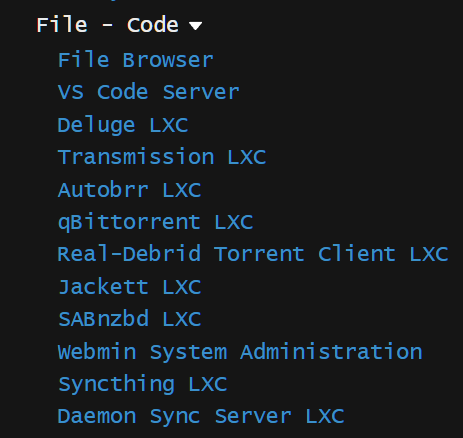[ad_1]
 Whereas BitTorrent shopper performance hasn’t basically modified over the previous 20 years, builders of main shoppers haven’t let their software program stagnate.
Whereas BitTorrent shopper performance hasn’t basically modified over the previous 20 years, builders of main shoppers haven’t let their software program stagnate.
instance is the wonderful qBittorrent, a feature-rich open supply shopper which nonetheless receives common updates. In widespread with comparable shoppers, qBittorent may be found on GitHub together with its supply and set up directions.
Elsewhere on the identical platform, customers had been lately making an attempt to work out how an ordinary qBittorrent set up out of the blue led to the looks of undesirable cryptocurrency mining software program on the identical machine.
Proxmox and LXC
For these unfamiliar with Proxmox VE, it’s an setting for digital machines that when tried turns into very helpful, extraordinarily shortly. It’s additionally free for mere mortals and in most circumstances, very simple to put in and stand up and operating.
 With assist from numerous Proxmox ‘helper scripts’ supplied by tteck on GitHub (small pattern to the correct), even newcomers can set up any of dozens of accessible software program packages in a matter of seconds utilizing LXC containers.
With assist from numerous Proxmox ‘helper scripts’ supplied by tteck on GitHub (small pattern to the correct), even newcomers can set up any of dozens of accessible software program packages in a matter of seconds utilizing LXC containers.
Even when none of that is smart, it doesn’t matter. Those that need qBittorrent put in, for instance, can copy and paste a single line of textual content into Proxmox…and that’s it. Provided that the entire course of is sort of all the time flawless, consumer points are very uncommon, so to listen to of a attainable malware an infection got here as an actual shock lately
Cryptominer Discovery
In abstract, a Proxmox consumer deployed a tteck script to put in qBittorrent after which a month later discovered his machine being labored laborious by cryptomining software program often known as xmrig. Whereas he investigated the issue, tteck eliminated the qBittorrent LXC script as a fundamental precaution, but it surely quickly grew to become clear that neither Proxmox or tteck’s script had something to do with the issue.
The unwelcome software program was certainly put in maliciously, however as a consequence of a collection of avoidable occasions, moderately than a genius hack.
When a qBittorrent set up like this completes and the software program is launched, entry to qBittorent takes place by way of an online interface accessible from most internet browsers. By default, qBittorrent makes use of port 8080 and since many customers wish to entry their torrent shoppers from distant networks, qBittorrent makes use of UPnP (Common Plug and Play) to automate port forwarding, thereby exposing the net interface to the web.

Having this working in report time is all very good, however that doesn’t imply it’s secure. To make sure that solely the operator of the shopper can entry the net interface, qBittorrent permits the consumer to configure a username and a password for authentication functions.
This usually signifies that random passers-by might want to possess these credentials earlier than having the ability to do injury. On this case, the default admin username and password weren’t modified and that allowed an attacker to simply entry the net interface.
Attacker Advised qBittorrent to Run an Exterior Program
To permit customers to automate numerous duties associated to downloading and organizing their information, qBittorrent has a characteristic that may mechanically run an exterior program when a torrent is added and/or when a torrent is completed.
The choices listed here are restricted solely by the creativeness and ability of the consumer however sadly the identical applies to any attacker with entry to the shopper’s internet interface.

On this case the attacker instructed the qBittorrent shopper to run a fundamental script on completion of a torrent. The script accessed the area http://cdnsrv.in from the place it downloaded a file known as replace.sh after which ran it. The results of which might be explained in detail by tteck, however the details are a) unauthorized cryptomining on the host machine and b) the attacker sustaining root entry by way of SSH key authentication.
Simply Averted
The default admin username for qBittorrent is ‘admin’ whereas the default password is ‘adminadmin’. Had these common-knowledge defaults been modified following set up, the attacker would nonetheless have discovered the net interface however would’ve had no helpful credentials for typical entry.
Extra basically, possession of the right credentials would’ve had restricted worth if the qBittorrent shopper hadn’t used UPnP to show the net interface within the first place. Taking one other step again, if UPnP hadn’t been enabled within the consumer’s router, qBittorrent would’ve had no entry to UPnP, and wouldn’t have been in a position to ahead ports or expose the interface to the web.
In abstract: disable UPnP within the router and solely allow it as soon as its operate is absolutely understood and when completely obligatory. By no means depart default passwords unchanged, and if one thing doesn’t must be uncovered to the web, don’t expose it unnecessarily.
Lastly, it’s value mentioning that tteck‘s response, to an issue that had nothing to do with Proxmox or his scripts, has been top quality. Anybody putting in the qBittorrent LXC from here will discover the default admin password modified and UPnP disabled mechanically.
Any time saved may be spent on automated installs of Plex, Tautulli, Emby, Jellyfin, Jellyseerr, Overseerr, Navidrome, Bazarr, Lidarr, Prowlarr, Radarr, Readarr, Sonarr, Tdarr, Whisparr, and lots of, many extra.

[ad_2]
Source link

